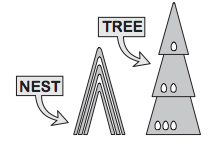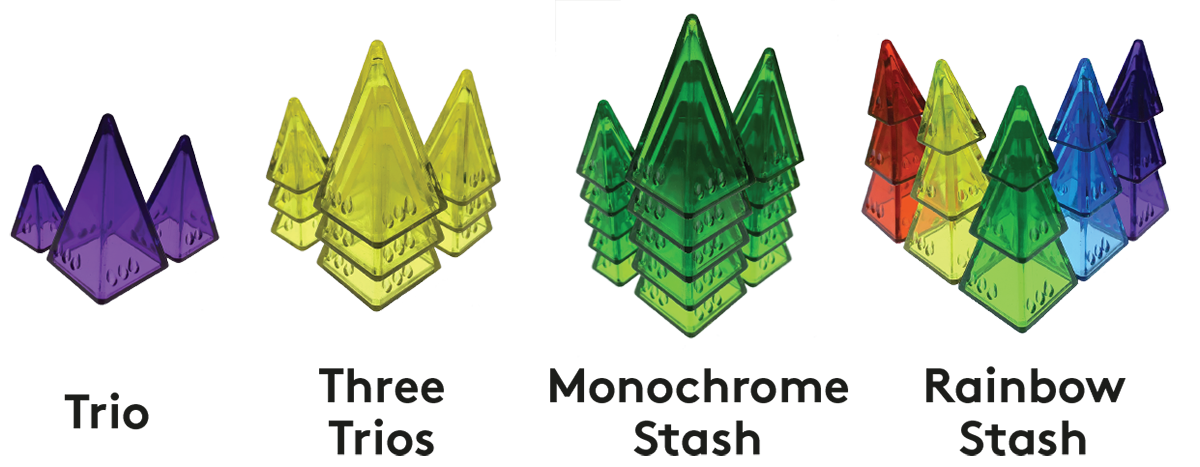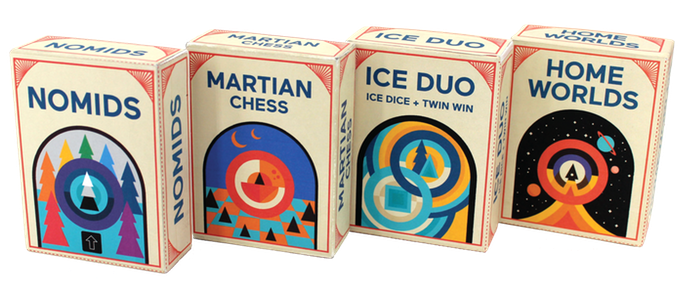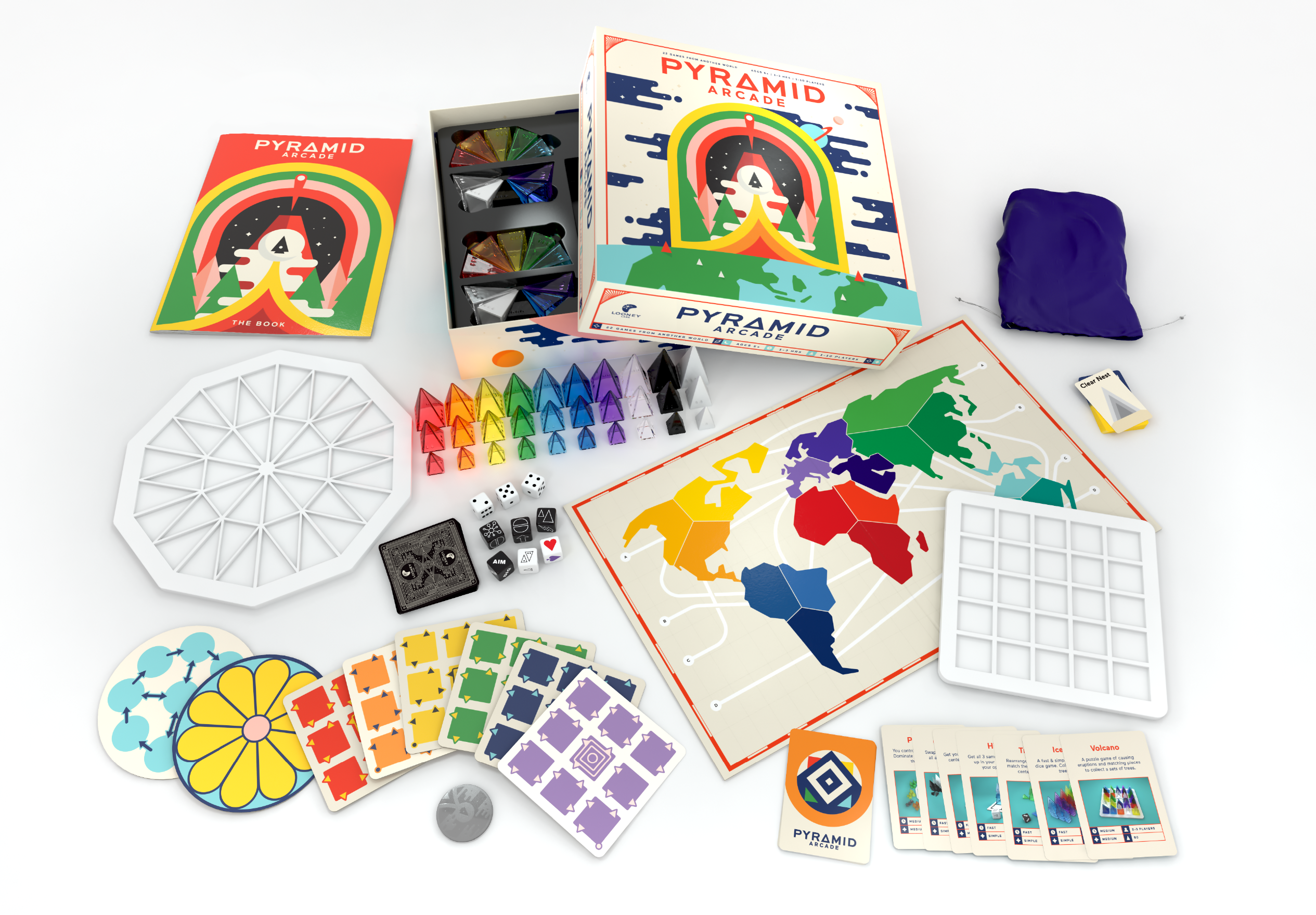This page is all about the hardware. We often compare the pyramids to a deck of playing cards, but they’re also akin to a computer. To play the games, you need the right equipment. If there’s a particular “app” you are interested in, you need to make sure your “machine” is compatible.
Pyramid Fundamentals
 Trio: Three same-color pyramids — a Small, a Medium, and a Large — are the basic units of the system. A trio is often called a tree, since the pieces resemble a pine tree when stacked. Each piece is marked with 1, 2, or 3 "pips."
Trio: Three same-color pyramids — a Small, a Medium, and a Large — are the basic units of the system. A trio is often called a tree, since the pieces resemble a pine tree when stacked. Each piece is marked with 1, 2, or 3 "pips."- Stash: Fifteen pyramids — 5 Trios — was defined in the original game as a Stash. If those pyramids are all the same color, then technically it’s a Monochrome Stash. A stash with five different colors is called a Rainbow stash.
- Trio of Trios: Many games were designed around the full monochrome stash. Many others require just a single trio of various colors. But it turns out that the “sweet spot” is three trios of each color. It’s the Goldilocks amount, providing a goodly supply of pieces, but not an excessive number.

-
Pyramid Arcade: This big beautiful box contains 22 different pyramid games and everything you need to play them all. Oriented around Three-Trio Sets, the Arcade contains 90 pyramids - 9 each of ten colors. It features a detailed, 76-page rulebook and includes “toolbox” of other equipment: 9 dice, 8 small gameboards, a large gameboard, 2 plastic gameboards, several decks of cards, a drawstring bag, and even a fancy metal turn token.
- Pyramid Quartet: Pyramid Arcade is an incredible package, however, owners interested in games that need a full stash (or more) of each color will be interested in expanding their set with more pyramids. The full arcade can also be overwhelming, both in terms of scope and cost. Therefore, a series of smaller games is being developed, which will serves both as expansion sets for Arcade owners looking to get more pyramids, and as easier entry points for new players. These new games are collectively known as Pyramid Quartet, since they were launched together under a Kickstarter campaign by that name.

- Nomids: The ideal starting point is this very simple introductory game, which also includes notes on several other games you can play with the set. It contains 30 pyramids (1 trio of each of the ten main colors) plus one “lightning” die.
- Ice Duo: This set is actually two complete games in one: Ice Dice, the classic press-your-luck pyramid game featured as a standalone game in 2011, and Twin Win, a simple hidden goal game. The Ice Duo set includes two trios each of 5 colors (red, yellow, green, cyan, and purple) plus special dice and the small board and cards needed for the two games.
- Martian Chess: This mind-bending pure strategy game uses a mini-chessboard but ignores color. So all 18 pieces are the same out-of-this-world hue. There are actually two versions of this product, each featuring an unique color. The Kickstarter exclusive limited edition contains shiny silver pieces, while the standard edition will contain opaque, “martian red” pieces.
- Homeworlds: This epic interstellar space battle game is one of the greatest abstract strategy games every designed. The set contains four Three-Trio Sets in the traditional colors (red, yellow, blue, and green).
- Pink Hijinks: The last surviving product from the previous way of marketing the pyramids is this cute little pyramid-shaped zippred bag containing 3 trios of pink pyramids plus the other stuff you need to play Hijinks.
- Kickstarter Green Pyramids: This special color was made for the 2016 KS campaign that launched Pyramid Arcade. Three-Trio Sets of these opaque green pyramids, packed simply in plastic baggies, are still available while supplies last.
- Crystal Caste Icehouse Pieces: These officially sanctioned collector’s items are the ultimate in fancy gaming equipment. Stock is subject to change, but as of this writing they were selling solid hematite pieces and stackable pieces from from obsidian, hematite, and green aventurine. (Check out this vintage review of the pieces from Andy's blog.)
- Second-Hand: Looney Labs has been selling these pyramids since 1999, with only slight modifications to the design (specifically, the tips have been rounded down). So, if you find a set of set of used pyramids for sale, scoop them up! They still work, and can be a great way to expand your collection. (Check the history page for details on how the packaging has changed over the years.)
- Giant Size: In 2001 we got a short run of giant cardboard pyramids. Someday we hope to make these again.
DIY Pyramids
There’s a grand tradition in crafting your own personalized set of pyramids that dates back to the days when the only way of getting a set was to create your own. This has become a lot easier with today’s world of 3D printing, which even makes it possible to make super-sized pyramids and other special items.
- Pyramid Specs: For those interested in crafting their own set by hand, here are the official dimensions, as recorded long ago. The exact mathematical formula for the shape of our pyramids, which was determined in 1990 by John's brother Kit, uses this equation: BaseSize = 4 / 7 FaceHeight = [ 4 + (2 ^ PipCount-1) ] / 8
- 3D Printing: Downloadable 3D models for the standard sized pyramids are avaialble at Thingiverse.com.
- Folded Paper: Real Origami Icehouse Pieces
Solid vs. Stackable
For more than a decade before the first injection-molded pyramids were introduced, all pyramids were solid. This was even regarded as preferable at the time, since it was important in the original game for a piece not to move at all once placed, meaning that the added weight of solidity was actually a bonus when playing Icehouse. Solid pieces are also much easier to cut out of wood or mold from clay. Of course, the ability to stack the pyramids opened up so many game design possibilities as to make solid pyramids larger obsolete. Even so, there are many games in which stacking is not required and a set from from solid wood pieces is unbeatable cool.
Non-Pyramid Equipment
As new games were invented for the pyramids, other new items of game equipment have also been created for use with the pyramids. Often when a new piece of pyramid-related gaming is released, other games will be invented that also use the new equipment, but in different ways.
Here’s a list of the most commonly used other equipment:
- Standard Dice: Regular D6 dice are great because everyone already has some!
- Chessboard: Again, you already have one of these.
- Treehouse Die: Created for as part of the new game Treehouse in 2006, and repurposed for a number of games thereafter, this D6 has faces that say AIM, DIG, SWAP, HOP, TIP, and WILD.
- Lightning Die: More generic than the Treehouse die, this D6 features six simple icons.
- Color Die: This D6 has 5 icons, one for each of the five colors Red, Yellow, Green, Cyan, and Purple. On the sixth face is the Wild icon from the Lightning die.
- Pyramid Die: This D6 has a Small, a Medium, and a Large pyramid on 3 of its faces, with the other 3 each showing a different pairing of the three pieces.
- Ice Dice: Since the Color Die and the Pyramid Die are both used by Ice Dice and were created for that game, these two are known as the Ice Dice.
- Volcano Board: A 5x5 grid with squares just big enough for the Large is known as a Volcano board, although it’s used by many other games.
- The Wheel: This round (well, 10-sided) board contains 40 triangular spaces. It was created for the game Petri Dish but now takes its name from the more popular solitaire game, Color Wheel.
- Zendo Stones: To play Zendo, you will also need about 60 tokens, 20 each of black, white, and some third color.
- Zendo Cards: Created for the standalone version of Zendo then retrofitted to work with the pyramids that first inspired the game, these rule cards make it easy to be the moderator. The deck of 60 multi-rule cards are ranked as easy, medium, or difficult and generate almost 400 different rules. [COMING SOON]
- Drawstring bag: Useful not only for carrying your pyramids around, but also for mixing up and pulling out pieces at random.
- Other Boards: Some games invoke their own specialized gameboards, such as the world map board needed for World War 5, or the Martian landscape played upon in Sandships. Some of these special boards are small, such as the Looney Ludo (aka Martian Coasters) boards, the Lunar Invaders (aka Cosmic Coasters) boards, the Petal Battle board, the Launchpad 23 board, and the Hijinks board (the last two of which are really just 3x3 grids).
- Other Cards: Some games also call for regular playing cards, or for cards with special information, like the hidden goals from Twin Win.
Other Notes
- The Looney Labs FAQ page has a section for Questions about Looney Pyramids, which includes some specifically relating to the pyramids themselves.
- Although the first generation of injection-molded pyramids were made in the USA, since 2011 they've been made in China.
- The first generation pyramids had sharper tips than the newer pyramids. In order to pass all international safety testing standards, the tips were made rounder. The photo below was used for advertising the system in 1999 and show the pointier tips.









